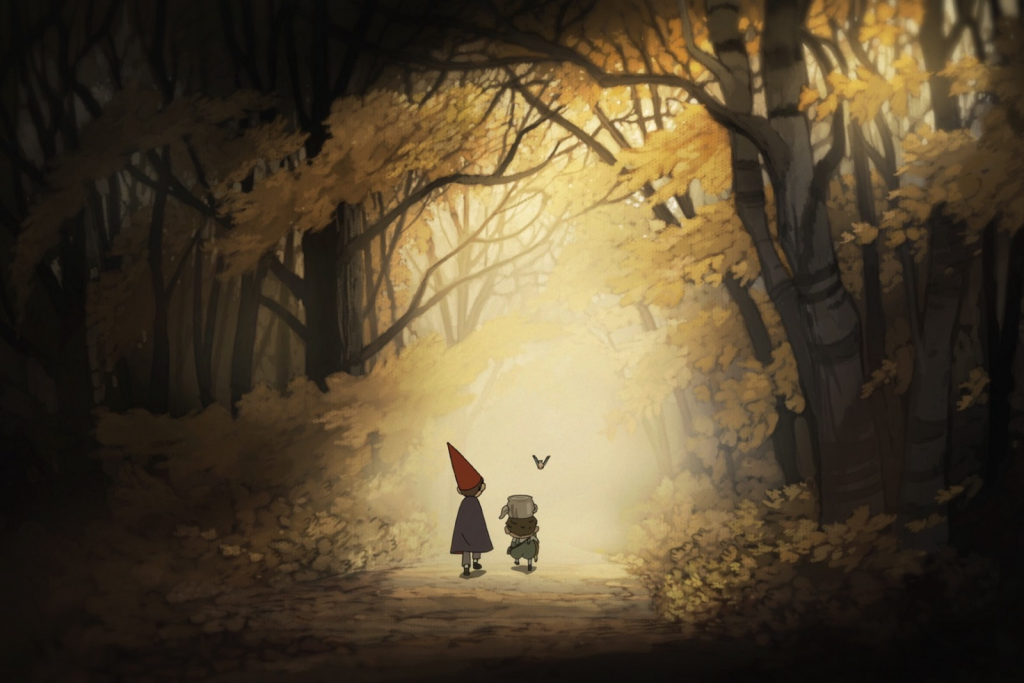“Over the Garden Wall,” from creator Patrick McHale — and its soundtrack, imagery and characters — are what you would get if you made a show based on those vintage Halloween postcards that cost 50 cents at antique stores. In fact, they were a major influence on the design and art of the series.
In the almost 10 years since the premiere of the series, the show has maintained a large but quiet fan base, with many citing its autumnal visuals as the thing that makes them return to the show every fall. The annual appeal of the show can be found most succinctly in its title sequence.
Rather than introducing the main characters of the series, we are instead treated to vignettes of the minor characters and fleeting settings that appear throughout the show’s 10 episodes — a cat in a turkey-drawn carriage, wooden toy versions of townsfolk, candlelit catacombs and the haunting forest that our main characters, Wirt and Greg, find themselves lost in.
The soundtrack of the series, composed and performed by The Blasting Company, also plays a role in the appeal of the series. According to the show’s creator, the soundtrack “finishes [the show] off and makes it the right feeling for the audience’s experience of this place where we can delve into, sometimes, genres of music that might not match what we’re watching but give you a certain feeling.” Despite the fact that the songs on the soundtrack can vary from each other, they are so unique from other soundtracks and distinct in the eclectic style of the show that it works wonders.
It is very easy for us to connect media to very specific feelings or times. The album you played the fall of your junior year will always be entwined with what you were going through at the time, good or bad. The songs you listened to during COVID-19 may not have an intrinsic element of anxiety or stress. But if that’s what you were feeling when those songs were on repeat, those emotions become embedded in your mind and resurface whenever you listen to them.
“Over the Garden Wall” possesses two different kinds of timeliness. There is the fact that the entire story is revealed to take place on Halloween, with pumpkins, mysterious forests and autumnal foliage making the season in which the story takes place very obvious. After all, that is the intended effect. In the words of McHale, “[i]t was definitely intended to be a Halloween special that could be revisited every year — we knew we weren’t making … SpongeBob … but we hoped that the series could become some sort of cult classic.”
What is more ambiguous is when the story takes place. With Wirt wearing suspenders, a cape and a cone hat, and his little brother, Greg, using a teapot as a hat à la Johnny Appleseed, it isn’t easy to parse the decade or even century that the characters find themselves in. The fantasy elements of the story certainly don’t parse it.
The ambiguousness of when the story takes place is central to its annual appeal. Whereas other shows include pop culture references or use technology that can date a series, the only piece of technology that is highlighted is a cassette tape, giving the single episode that takes place in the “modern day” the possibility of occurring anywhere from 1963 to today.
The rest of the show fully buys into its premise — Wirt never looks at the camera to deliver a witty one-liner. You are able to become fully immersed in the world’s fantasy, without thinking that a meme reference hasn’t been relevant in 10 years.
By being so out-of-time, the show can be placed into any time and related to by anyone. As the brothers walk through a dark forest, you remember both cool autumn days spent outside with friends, and the nervousness you felt when, for a split second, you thought you were lost. The fall memories you make when you’re six, 13 and 19 all have their place in the story, combining our cultural understanding of the season in a honorific, if slightly haunted, way.
The horror elements of the story are central to the show, but they do not overpower it. Well interspersed with character-focused and beautifully animated sequences, it strikes a wonderful balance. After all, you can’t have the beauty of fall foliage without some slightly scary costumes and spooky forests.
Rather than the current, trendy, fall ephemera you might find in Target, the story beckons forward the mystery and terror of fall, especially as it is in the Northeast — the harvest season before the bitter cold, the last hurrah before you had to hunker down in front of the fire. When the series antagonist, the Beast, begins to suck the hope out of the characters in the story and nearly succeeds, the whimsy of the earlier episodes disappear to a white expanse of terror.
But those times of walking down the ice in front of your dorm as carefully as possible only to fall are not here yet. So as the temperature continues to drop, the leaves begin to glow and everything goes purple and orange, transport yourself back in time to a terrifying yet heartening season with “Over the Garden Wall.”



